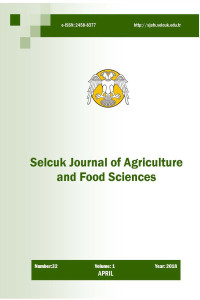The Conformity Study of Chemical Composition of Some Commercial Flower Honey Samples Sold in Markets in the city of Konya, Turkey with Turkish Food Codex, Honey Communique
Abstract
In the study, some chemical composition of different flower honey brands sold in markets in the city of Konya and the conformity of these features with Turkish Food Codex, Honey Communique were studied. In this respect, 5 different honey samples were evaluated for pH, humidity, the number of diastase, proline, HMF, sucrose, fructose/glucose ratio, fructose+glucose ratio, the differences of protein in honey and delta C13 value of crude honey, and C4 sugar ratio. Whether the results conform to Turkish Food Codex or they are the same with other samples was studied. Till analysis, all samples were kept in dark room after they were obtained from the markets. pH levels of the samples were relatively 4.20, 3.91, 4.00, 4.37, 3.94 and the humidity levels were 17.13, 16.55, 15.48, 16.48, 17.63 (%). The level of acidity was (meq/kg) 25.75, 22.78, 22.39, 34.06, 20.27 and the numbers of diastase were 12.86, 13.02, 14.22, 22.45, 13.46. The quantity of proline was (mg/kg) 597.55, 515.17, 581.23, 699.05, 487.81 and HMF content (mg/kg) was 4.17, 17.12, 13.06, 6.75, 23.75, respectively, however, the quantity of sucrose was not identified. The ratio of fructose/glucose was 1.06, 1.09, 1.09, 1.19, 1.09 and fruc-tose+glucose ratio (%) was 70.39, 73.39, 73.52, 65.20, 70.30. The difference between protein and delta C13 value of crude honey was -0.55, -0.28, 0.25, 1.95, 0.13. C4 Sugar ratio was (%) 3.53, 1.93, 0.00, 0.00, 0.00, respectively. Although the samples included in the study had significant differences from each other (P<0.01), their all features were in accordance with Turkish Food Codex, Honey Communique.
Konya Bölgesindeki Marketlerde Satılan Farklı Ticari Çiçek Ballarının Bazı Kimyasal Özelliklerinin Türk Gıda Kodeksi Bal Tebliğine Uygunluğunun Araştırılması
Abstract
Bu çalışmada Konya bölgesindeki marketlerde satışa sunulan farklı firmalara ait çiçek ballarının bazı kimyasal özelliklerinin Türk Gıda Kodeksi-Bal Tebliğine uygunluğu kıyaslaması yapılmıştır. Bu amaçla marketlerde satışa sunulan 5 farklı firmaya ait çiçek ballarında pH, nem, asitlik, diastaz sayısı, prolin, HMF, sakkaroz, fruktoz/glukoz oranı, fruktoz + glukoz oranı, Balda protein ve ham bal delta C13 değerleri arasındaki fark, C4 şekerler oranı analizleri yapılmıştır. Sonuçların Türk Gıda Kodeksi Bal Tebliğine uygun olup olmadığı ve diğer örneklerle benzerlik gösterip göstermediği kontrol edilmiştir. Tüm örnekler marketlerden satın alınarak analizler yapılıncaya kadar karanlıkta oda sıcaklığında depolanmıştır. Firmalara ait bal örneklerinin sırasıyla pH değerleri; 4.20, 3.91, 4.00, 4.37, 3.94, nem değerleri (%); 17.13, 16.55, 15.48, 16.48, 17.63, asitlik değerleri (meq/kg); 25.75, 22.78, 22.39, 34.06, 20.27, diastaz sayıları; 12.86, 13.02, 14.22, 22.45, 13.46, prolin miktarları (mg/kg); 597.55, 515.17, 581.23, 699.05, 487.81, HMF içerikleri (mg/kg); 4.17, 17.12, 13.06, 6.75, 23.75 olarak tespit edilmiş, ancak sakkaroz miktarları (%); tespit edilememiştir. Sırasıyla fruktoz/glukoz oranı; 1.06, 1.09, 1.09, 1.19, 1.09, fruktoz + glukoz oranı (%); 70.39, 73.39, 73.52, 65.20, 70.30, Balda protein ve ham bal delta C13 değerleri arasındaki fark; -0.55, -0.28, 0.25, 1.95, 0.13, C4 şeker oranı (%); 3.53, 1.93, 0.00, 0.00, 0.00 olarak bulunmuştur. Araştırmada kullanılan firmalara ait bal örnekleri arasında (P<0.01) önemli farklar olmasına rağmen Türk Gıda Kodeksi-Bal Tebliğine uygun bulunmuştur.
Details
| Primary Language | English |
|---|---|
| Subjects | Zootechny (Other) |
| Journal Section | Research Article |
| Authors | |
| Publication Date | April 27, 2018 |
| Submission Date | November 23, 2017 |
| Published in Issue | Year 2018 Volume: 32 Issue: 1 |
Cite
Selcuk Agricultural and Food Sciences is licensed under a Creative Commons Attribution-NonCommercial 4.0 International License (CC BY NC).


